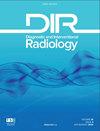MRI-directed cognitive fusion-guided biopsy of the anterior prostate tumors.
IF 1.7
4区 医学
Q2 Medicine
引用次数: 22
Abstract
PURPOSE We aimed to evaluate the efficacy of magnetic resonance imaging (MRI)-directed cognitive fusion transrectal ultrasonography (TRUS)-guided anterior prostate biopsy for diagnosis of anterior prostate tumors and to illustrate this technique. METHODS A total of 39 patients with previous negative TRUS biopsy, but high clinical suspicion of occult prostate cancer, prospectively underwent prostate MRI including diffusion-weighted imaging (DWI). Patients with a suspicious anterior lesion on MRI underwent targeted anterior gland TRUS-guided biopsy with cognitive fusion technique using sagittal probe orientation. PIRADS version 1 scores (T2, DWI, and overall), lesion size, prostate-specific antigen (PSA), PSA density, and prostate gland volume were compared between positive and negative biopsy groups and between clinically significant cancer and remaining cases. Logistic regression analysis of imaging parameters and prostate cancer diagnosis was performed. RESULTS Anterior gland prostate adenocarcinoma was diagnosed in 18 patients (46.2%) on targeted anterior gland TRUS-guided biopsy. Clinically significant prostate cancer was diagnosed in 13 patients (33.3%). MRI lesion size, T2, DWI, and overall PIRADS scores were significantly higher in patients with positive targeted biopsies and those with clinically significant cancer (P < 0.05). Biopsies were positive in 90%, 33%, and 29% of patients with overall PIRADS scores of 5, 4, and 3 respectively. Overall PIRADS score was an independent predictor of all prostate cancer diagnosis and of clinically significant prostate cancer diagnosis. CONCLUSION Targeted anterior gland TRUS-guided biopsy with MRI-directed cognitive fusion enables accurate sampling and may improve tumor detection yield of anterior prostate cancer.mri引导的认知融合引导前列腺前肿瘤活检。
目的探讨磁共振成像(MRI)引导认知融合经直肠超声(TRUS)引导前列腺前路活检对前列腺前路肿瘤的诊断价值。方法对39例既往TRUS活检阴性,但临床高度怀疑隐匿性前列腺癌的患者,前瞻性行前列腺MRI包括弥散加权成像(DWI)。在MRI上有可疑前路病变的患者采用矢状面探针定向的认知融合技术进行靶向前腺活检。PIRADS版本1评分(T2、DWI和总体)、病变大小、前列腺特异性抗原(PSA)、PSA密度和前列腺体积在活检阳性组和阴性组之间以及临床显著癌和剩余病例之间进行比较。对影像参数与前列腺癌诊断进行Logistic回归分析。结果有针对性的前腺超声引导活检诊断前腺前列腺癌18例(46.2%)。有临床意义的前列腺癌13例(33.3%)。MRI病变大小、T2、DWI、PIRADS总评分在靶向活检阳性患者和有临床意义的癌症患者中均显著升高(P < 0.05)。90%、33%和29%的患者活检呈阳性,PIRADS总分分别为5分、4分和3分。PIRADS总分是所有前列腺癌诊断和具有临床意义的前列腺癌诊断的独立预测因子。结论基于trus引导的前腺活检结合mri引导下的认知融合能够准确取样,提高前前列腺癌的肿瘤检出率。
本文章由计算机程序翻译,如有差异,请以英文原文为准。
求助全文
约1分钟内获得全文
求助全文
来源期刊
CiteScore
3.50
自引率
4.80%
发文量
69
审稿时长
6-12 weeks
期刊介绍:
Diagnostic and Interventional Radiology (Diagn Interv Radiol) is the open access, online-only official publication of Turkish Society of Radiology. It is published bimonthly and the journal’s publication language is English.
The journal is a medium for original articles, reviews, pictorial essays, technical notes related to all fields of diagnostic and interventional radiology.

 求助内容:
求助内容: 应助结果提醒方式:
应助结果提醒方式:


